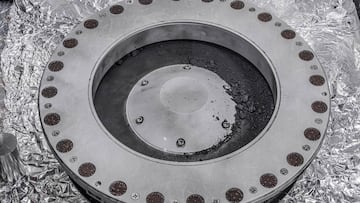What did NASA discover in samples from the Bennu asteroid?
The asteroid sample, brought to Earth by the OSIRIS-REx probe, contains water and carbon. The exhaustive analysis of the fragments of this space rock could give us answers about the origin of life on our own planet.

Initial studies of samples from the 4.5 billion-year-old asteroid Bennu collected in space by Osiris-REx and brought back to Earth by the National Aeronautics and Space Administration (NASA), show evidence of water and a high carbon content. For the agency, this could indicate “how the precursor materials to life may have been seeded on Earth.”
NASA reported this news with great emotion from its Johnson Space Center in Houston, where leaders and scientists have displayed the asteroid material for the first time since it landed on September 24.
Exhaustive analysis
“The OSIRIS-REx sample is the biggest carbon-rich asteroid sample ever delivered to Earth and will help scientists investigate the origins of life on our own planet for generations to come,” NASA administrator Bill Nelson has conveyed.
In the past two weeks, scientists have carried out a rapid analysis for an initial understanding of the material from Bennu, the third asteroid from which samples have been collected and brought to Earth - after it was achieved by the Japanese probes Hayabusa 1 and 2, in 2010 and 2020, respectively.
Carbon and water molecules are “necessary” for life
In this first analysis, the presence of water and organic molecules in the clay has been revealed. For this, X-ray computed tomography has been used. In this way, it has been possible to produce a 3D computer model of one of the particles, highlighting its diverse interior.
The principal investigator of OSIRIS-REx, Dante Lauretta, who has pointed out that carbon and water molecules are “necessary” for life, has highlighted that as we “look” at the ancient secrets preserved within the dust and rocks of the asteroid Bennu, “we are unlocking a time capsule that offers us profound insights into the origins of our solar system.”
“The bounty of carbon-rich material and the abundant presence of water-bearing clay minerals are just the tip of the cosmic iceberg,” said Lauretta.
NASA says it's found water, carbon and organic matter on an asteroid sample that returned to Earth last month. The samples were collected by the OSIRIS-REx spacecraft from an asteroid called ‘Bennu’ in October 2020 https://t.co/n442kOKgM5 pic.twitter.com/sSPdEkXuS0
— Reuters (@Reuters) October 12, 2023
NASA seeks to answer questions about who we are and where we come from
Related stories
NASA will retain at least 70% of the sample at its Johnson Space Center in Houston for future research by scientists around the world, including future generations of scientists. News that has generated a diversity of opinions on social networks.
With all this, it is worth noting that almost everything NASA does seeks to answer questions about who we are and where we come from. That’s why missions like OSIRIS-REx improve our understanding of asteroids that could threaten Earth, while giving us insight into what lies beyond.

